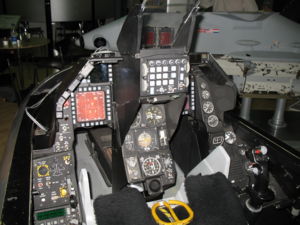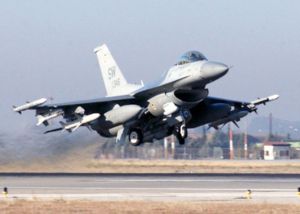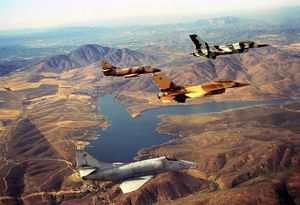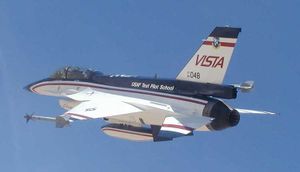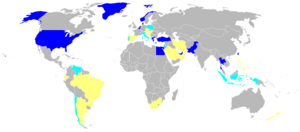PlaneSpottingWorld welcomes all new members! Please gives your ideas at the Terminal.
F-16 Fighting Falcon
| F-16 Fighting Falcon | |
|---|---|
| Type | Multirole fighter |
| Manufacturer | General Dynamics/Lockheed Martin |
| Maiden flight | 1974-02-02 |
| Introduced | 1978-08-17 |
| Status | Active service |
| Primary users | United States Air Force 24 other users |
| Number built | >4,000 |
| Unit cost | US$18.8 million (1998) |
| Variants | General Dynamics F-16XL Mitsubishi F-2 |
The F-16 Fighting Falcon is a multirole jet fighter aircraft developed by General Dynamics in the United States. Designed as a lightweight fighter, it evolved into a successful multi-role aircraft. The Falcon's versatility is a paramount reason it was a success on the export market, serving 24 countries.[1] The F-16 is the largest and probably most significant current Western fighter program, with over 4,000 aircraft built since production started in 1976. Though no longer produced for the United States Air Force, it is still produced for export.
The Fighting Falcon is regarded as a superb dogfighter, with innovations including a frameless canopy for better visibility, side-mounted control stick to ease control while under high g-forces, and reclined seat to reduce the effect of g-forces on the pilot. It was also the first fighter aircraft to be deliberately built to sustain 9g turns. It is also one of the few jets with a thrust-to-weight ratio greater than one, giving the Falcon excellent acceleration.
Although the F-16's official name is "Fighting Falcon", it is known to its pilots as the "Viper", after the Battlestar Galactica starfighter.[2]
In 1993 General Dynamics sold its aircraft manufacturing business to the Lockheed Corporation, which in turn became part of Lockheed Martin after a 1995 merger with Martin Marietta.
Contents
History
Main article: Light Weight Fighter
During the 1960s the U.S. Air Force and Navy both concluded that the future of air combat would be determined by increasingly sophisticated missiles. Future "fighters" would be designed primarily for long range, high speed, and equipped with extremely large radar systems in order to detect opposing fighters at long range. This made them much more like interceptors than classic fighter designs. In the early 1960s both the Air Force and Navy expected to use the F-111 (then still in development as the TFX) and F-4 Phantoms for their long and medium range needs complemented by several single-engine designs including upgraded F-100 Super Sabres, F-104 Starfighters, and F-8 Crusaders. Future twin-engine fighter programs were getting underway and the Air Force began a replacement for its single-engine fighter designs to maintain its high-low mix of air superiority aircraft.
Real-world experience in the Vietnam War showed the continued need for the 'high-low' fighter matrix system. Soviet-bloc fighters over Vietnam were proving to be more of a problem than expected for US designs. Even though the US had very large kills to losses ratio in its favor, combat revealed some shortcomings. Missiles of this era still had notable reliability issues, and restrictions on how they were used functionally. Combat invariably closed to short ranges where air-combat maneuverability and short range air-air weapons became critical. Dedicated interceptors like the F-102 Delta Dagger had also been tested in combat which revealed certain shortcomings. Although US training, doctrine and air control more than made up for these disadvantages, it was nevertheless clear to some in the Air Force that the all-missile doctrine was seriously flawed. Both aircraft of the future High-Low mix for the USAF would have guns (F-15 and F-16).
In particular, Colonel John Boyd developed the theory of energy maintenance in fighter combat, which relied on larger wings in order to preserve maneuverability. Larger wings would mean more drag in flight, usually resulting in lower range and slower top speed (although larger wings can also result in greater range due to increased payload and fuel). He felt this was a fair trade-off for a "real" fighter design. At about this time the navalized F-111 was running into serious problems, and was eventually abandoned in favor of a new design, the F-14 Tomcat. A combination of Boyd's tireless advocacy of maneuverability, and what is often viewed as a failure of the F-111 to develop into a suitable fighter, and notably the rather over-inflated performance estimates of the MiG-25 led the USAF to also start development of their own fighter design, the F-15 Eagle.
It was not long before the F-15 started growing into a very large design that appeared to be turning into an "F-111 mark II". Boyd was frustrated by this development, and convinced a number of others that the F-15 would need to be complemented by larger numbers of smaller fighters like previous twin-engine fighters. A group of interested parties formed the self-named "fighter mafia" and agitated for the development of the Light Weight Fighter. They eventually won a small amount of money, only $149,000 (~$715,000 year 2000 dollars) to conduct studies into such a design. Northrop had always been a proponent of light-weight designs and had continually developed plans for an advanced F-5 Freedom Fighter, and received $100,000. General Dynamics, looking to redeem themselves from the controversial F-111, received the remainder.
In May 1971 the US Congress released a report that was highly critical of both the F-14 and F-15 programs. They proposed funding the LWF with $50 million and an additional $12 million the next year. Several companies submitted proposals, but GD and Northrop had such a head start that they were both asked to produce prototypes for head-to-head testing. These were ready in 1974, and in extensive testing General Dynamics' YF-16 proved somewhat better all-round, winning the LWF contest.
By this time a number of countries were looking for a multi-role replacement for their existing F-104Gs and other older designs. Up to this point, the LWF was merely an evaluation program with no plans to purchase models, but the possibility of a European order lead the Pentagon to reconsider. The Air Force was now seeking a multi-role fighter to replace the F-105, so the program was renamed the Air Combat Fighter (ACF). In September 1974, the Air Force announced plans to purchase 650 ACF's. On 13 January, 1975, Secretary of the Air Force John McLucas announced the selection of the YF-16, beating out Northrop's YF-17.
Design characteristics
The F-16 is a single-engined, multi-role tactical aircraft. It is equipped with an M61 Vulcan cannon in the left wing root, and was almost always armed with two AIM-9 Sidewinder missiles, one on each wingtip on a dedicated rail. More recent versions can be equipped with the AIM-120 AMRAAM on these rails instead. It can also be armed with a wide variety of air-to-air missiles and air-to-ground missiles, rockets or bombs, carried on a number of hardpoints under the wings.
From the very beginning, the F-16 was intended to be a cost-effective "workhorse" that could perform various kinds of missions and maintain around-the-clock readiness. It is much simpler and lighter than its predecessors, but uses advanced aerodynamics and avionics (including the first use of fly-by-wire, earning it the nickname of "the electric jet") to maintain good performance.
Ergonomics and visibility
The pilot sits high in the fuselage with the canopy support-bow behind him, out of his field of view. This and the bubble canopy give the pilot an unobstructed field of view, a feature vital during air-to-air combat. The seat is reclined 30 degrees (other seats are typically inclined around 13 degrees) to help the pilot endure high accelerations (g-forces). The control stick is mounted on the right armrest rather than between the legs as is traditional, to aid in maneuvering during high g-force turns. In addition, a Heads-Up Display (HUD) displays vital information in the pilot's field of view.
With the exception of the HUD, many of these features remain controversial to this day.[citation needed] The side-mounted stick makes it difficult for the pilot to "switch hands" in order to operate cockpit controls with the right hand, often forcing them to use their left hand to operate controls on the center or right side of the cockpit (the latter being few).[citation needed] The reclined seat makes this difficult, as well as making it somewhat more difficult to look directly to the rear, one of the major advantages of the large canopy.[citation needed] It has been suggested that the actual benefit in terms of g capability is very close to zero, and the real reason for the large incline was to make the seat fit into the aircraft. The canopy itself has the problem of having to be much thicker than in most aircraft, where only the portion between the cockpit frame and nose have to be thick enough to guard against bird strikes. The F-16's canopy has to be much thicker overall, and as a result is quite heavy and the seat cannot be ejected through it.[citation needed]
It is worth noting that some of these features have been used on newer aircraft design. The F-22 uses a single-piece canopy like the F-16, although the F-35 and Eurofighter Typhoon do not. Seat angles have universally been less than the F-16, normally around 15 degrees. The F-22 and F-35 both have deeper forward fuselages than the F-16, which must be very shallow to avoid negatively impacting airflow into the chin-mounted intake.[citation needed]
Fly by wire
The F-16 uses computerized fly-by-wire and has no mechanical linkages between the control stick and the flight surfaces. Computer control is necessary for flight as a result of the inherent negative stability of the aircraft, a trait which trades stable flight for increased maneuverability.
This lack of mechanical linkages between the control stick and the flight surfaces led to an unusual characteristic in the design of the control stick: originally, it did not move. The control stick instead detected pressure applied by the pilot and translated that pressure into control of the aircraft. This arrangement proved uncomfortable and difficult for pilots to adjust to, so the control stick was given a small amount (less than a quarter of an inch in any direction) of play.
The onboard computer makes thousands of calculations and corrections each second to keep the plane flying, freeing pilots to concentrate on tasks necessary to fulfill their intended role. The enhanced computer oversight also provides automatic flight coordination, utilizing all control surfaces (including the rudder) to keep the aircraft from entering performance hurting or even potentially dangerous situations such as unintentional slips or skids. This led to a common refrain heard from pilots: "You don't fly an F-16; it flies you".
Wing and Strake Configuration
Aerodynamic studies in the early 1960s demonstrated that the phenomenon known as “vortex lift” could be beneficially harnessed by the utilization of highly swept wing configurations, such as found in the Concorde supersonic aircraft and the Swedish Viggen canard configured aircraft. These favorable effects affected the aircraft’s lift capability and allowed the close-coupled wing to be extended to create higher angles of attack through use of a strong leading-edge vortex flow of a slender lifting surface. The leading edge of the wing’s blended forebody would thus increase the strength of the vortices and give the aircraft additional lift.
The exploitation of this aerodynamic phenomenon shaped the design of the F-16, which boasts cropped delta wings and long wing-body strakes, and is considered to be one of the significant elements responsible for its enduring success as a highly maneuverable fighter.
Negative static stability
An aircraft with negative static stability will, in the absence of control input, depart from level and controlled flight. Most aircraft are designed with positive static stability, where a plane tends to return to its original attitude following a disturbance. However, positive static stability hampers maneuverability, as the tendency to remain in its current attitude opposes the pilot's effort to maneuver; therefore, a plane with negative static stability will be more maneuverable. With a fly-by-wire system, such a plane can be kept in stable flight, its instability kept in check by the flight computers.
The YF-16 was the world's first aircraft to be slightly aerodynamically unstable by design. This feature is officially called "relaxed static stability." At subsonic speeds, the airplane is constantly on the verge of going out of control. This tendency is constantly caught and corrected by the FLCC (Flight Control Computer) and later the DFLCC (Digital Flight Control Computer), allowing for stable flight. When supersonic, the airplane exhibits positive static stability due to aerodynamic forces shifting aft between subsonic and supersonic flight.
Combat service
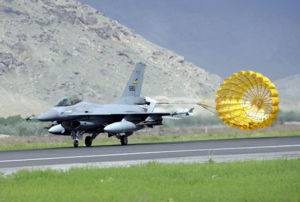
Due to their ubiquity, the F-16s have participated in numerous conflicts, most of them in the Middle East.
In 1981, eight Israeli F-16s participated in a raid that destroyed Osiraq, an Iraqi nuclear reactor near Baghdad. During the same year, the Israeli Air Force obtained the first air-to-air "kills" for the entire F-16 series, shooting down a Syrian Mi-8 helicopter and a MiG-21 jet. The following year, during Operation Peace for Galilee (Lebanon War) Israeli F-16s engaged Syrian aircraft successfully on numerous occasions. F-16s were also used afterwards in their ground-attack role for strikes against targets in Lebanon.[citation needed]
During the Soviet-Afghan war, Pakistan Air Force F-16s shot down at least 10 Afghan and Soviet ground attack and transport aircraft (1986-1988).[3] The same border clash first saw the F-16's unusual dogfighting skills performed by the Pakistan Air Force.
In Operation Desert Storm of 1991, 249 USAF F-16s flew over 13,000 sorties in strikes against Iraq, the most of any Coalition aircraft, with five lost in combat, three to surface-to-air missiles (SAM), one to a premature bomb detonation, and one to an engine fire. F-16s returned to Iraq in force in 1998 as part of the Operation Desert Fox bombing campaign and again in the 2003 Operation Iraqi Freedom invasion, flying ground support and SEAD missions.
F-16s were also employed by NATO during Bosnian peacekeeping operations in 1994-95 (one was lost to a SAM, resulting in the evasion and recovery of Captain Scott O'Grady), in the 1999 Operation Allied Force in Yugoslavia (during which one was lost to ground fire), and by the United States in Afghanistan since 2001. Two air-to-air victories were scored by USAF F-16s in Operation Southern Watch,[4] four in Bosnia, and two in Operation Allied Force (one by a Royal Netherlands Air Force F-16 which shot down a Serb MiG-29 with an AMRAAM).
In 2002, a tri-national detachment known as the European Participating Air Forces of 18 Danish, Dutch and Norwegian F-16s in the ground attack role deployed to Manas Air Base in Kyrgyzstan to support Operation Enduring Freedom in Afghanistan.
US F-16s would also participate in the 2003 invasion of Iraq. One F-16 crashed in June 2003 over Iraq due to fuel starvation.
On June 7, 2006, F-16s carried out two airstrikes which killed Abu Musab Al-Zarqawi, the leader of Al-Qaeda in Iraq, using two 500 lb bombs to destroy the al-Qaeda safehouse he was in.
Israeli F-16s were believed to have participated in the 2006 Israel-Lebanon conflict, since the aircraft is known to be the bomber workhorse of the Israel Defense Forces. The exact extent of the F-16's role in that conflict was not known publicly as of late July 2006 but was widely believed to be extensive. An IDF F-16I reportedly crashed on July 19 when one of its tires burst as it took off for Lebanon from an air base in the Negev. The pilots ejected safely and there were no casualties on the ground.
Since February 2006, Eight Royal Netherlands Air Force, joined by four Royal Norwegian Air Force F-16s are supporting ISAF ground troops in predominantly the southern provinces of Afghanistan. The detachment is know as the 1st Netherlands-Norwegian European Participating Forces Expeditionary Air Wing (1 NLD/NOR EEAW). [1] On August 31 a pilot of the Royal Netherlands Air Force was killed when his airplane crashed in Ghazni province.[2]
Variants
F-16 models are denoted by sequential block numbers to denote significant upgrades. The blocks cover both single- and two-seat versions. An intricate Multinational Staged Improvement Program (MSIP) was instituted to gradually upgrade the F-16 and retroactively implement the upgrades in delivered aircraft.
F-16 A/B
The F-16 A/B was initially equipped with the Westinghouse AN/APG-66 Pulse-doppler radar, Pratt & Whitney F100-PW-200 turbofan, rated at 14,670 lbf (64.9 kN), 23,830 lbf (106.0 kN) with afterburner. The USAF bought 674 F-16As and 121 F-16Bs, with delivery completed in March 1985.
- Blocks 1
- Early blocks (Block 1/5/10) with relatively minor differences between each. Most were later upgraded to the Block 10 configuration in the early 1980s. There were 94 Block 1, 197 Block 5, and 312 Block 10 aircraft produced. Block 1 is the early production model with the nose cone painted black.
- Block 5
- It was discovered that the black nose cone became an obvious visual identification cue at long range for the Block 1 aircraft, so the color of the nose cone was consequently changed to the low visibility grey for Block 5 aircraft. During the operation of F-16 Block 1, it was discovered that rain water could accumulate in certain spots within the fuselage, so drainage holes were drilled in the forward fuselage and tail fin area for Block 5 aircraft.
- Block 10
- The Soviet Union significantly reduced the export of titanium during the late 1970s, so manufacturers of the F-16 used aluminum instead. New methods were also used: the corrugated aluminum is bolted to the epoxy surface for Block 10 aircraft, replacing the old method of aluminum honeycomb being glued to the epoxy surface used in earlier aircraft.
- Block 15
- The first major change in the F-16, the Block 15 aircraft featured larger horizontal stabilizers, the addition of two hardpoints to the chin inlet, improved AN/APG-66 radar, increased capacity of underwing hardpoints. The F-16 gained the Have Quick II secure UHF radio. To counter the additional weight of the new hardpoints, the horizontal stabilizers were enlarged by 30%. Block 15 is the most numerous variant of the F-16, with 983 produced. The last one was delivered in 1996 to Thailand.
- Block 15 OCU
- From 1987 Block 15 aircraft were delivered to the Operational Capability Upgrade (OCU) standard, which featured improved F100-PW-220 turbofans with digital control interface, the ability to fire the AGM-65, AMRAAM, and AGM-119 Penguin missiles, countermeasures and cockpit upgrades, improved computers and data bus. Its maximum takeoff weight increased to 37,500 lb (17,000 kg). 214 aircraft received this upgrade, as well as some Block 10 aircraft, retroactively.
- Block 20
- 150 Block 15 OCUs for the Republic of China (Taiwan) with the addition of most of the F-16 C/D Block 50/52 capability: carriage of AGM-45 Shrike, AGM-84 Harpoon, AGM-88 HARM, and the LANTIRN pod. The computers onboard Block 20 is significantly improved in comparison to that of the earlier versions, with the overall processing speed increased 740 times and the overall memory storage increased 180 times in comparison to that of Block 15 OCU.
F-16 C/D
- Block 25
- The Block 25 F-16C first flew in June 1984 and entered USAF service in September. The aircraft are fitted with the Westinghouse AN/APG-68 radar, have a precision night attack capability and are fitted with the Pratt & Whitney F100-PW-220E turbofan, with digital control interface. The Air National Guard and Air Education and Training Command are the sole users of this variant, with 209 models delivered.
- Block 30/32
- The first aircraft subject to the Alternative Fighter Engine project under which aircraft could be fitted with the traditional Pratt & Whitney engines or for the first time the General Electric F110. Blocks ending in '0' are powered by GE, blocks ending in '2' are fitted with Pratt & Whitney engines.
The first Block 30 F-16 entered service in 1987. Major differences include the carriage of the AGM-45 Shrike and AGM-88 HARM missiles. From Block 30D aircraft were fitted with enlarged inlets for the increased thrust GE engine, Block 32s were not modified in this way. 733 were produced and delivered to six countries. The Block 32H/J aircraft assigned to the USAF Thunderbird flight demonstration squadron were built in 1986 and 1987 and are some of the oldest operational F-16's in the Air Force. The Block 30's were upgraded significantly with the addition of the Embedded Global Positioning satellite (GPS) Inertial Navigation System (EGI) allowing the use of JDAM and other GPS aided munitions (See Block 50 list below). This capability in combination with the Grumman LITENING targeting pod enhanced and extended the usability and lifespan of this block of the F-16C. This modification to the baseline Block 30 is commonly known by Viper Drivers as the F-16C++ (pronounced 'plus plus') version. - Block 40/42 (F-16 CG/DG)
- Entering service in 1988, the Block 40/42 is the improved all-day/all-weather strike variant with LANTIRN pod, the night capability gives rise to the name "Night Falcons". The block features strengthened and lengthened undercarriage for LANTIRN pods, improved radar, and a GPS receiver. From 2002 the Block 40/42 increases the weapon range available to the aircraft including JDAM, JSOW, WCMD and the (Enhanced) EGBU-27. Also incorporated in this block was the addition of ANVIS compatible lighting systems. The TCTO (Time Compliance Technical Order) that added the NVIS compatible systems was completed in 2004. 615 aircraft were delivered to 5 countries.
- Block 50/52 (F-16 CJ/DJ)
- Block 50/52 was first delivered in late 1991; the aircraft are equipped with improved GPS/INS. The aircraft can carry a further batch of advanced missiles; the AGM-88 HARM missile, JDAM, JSOW and WCMD. Block 50 aircraft are powered by the F110-GE-129 while the Block 52 jets use the F100-PW-229.
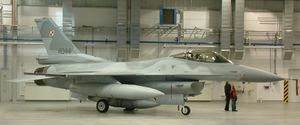
- Block 50/52 Plus (F-16U)
- Ordered by Polish Air Force. These aircraft are fitted with the latest avionics (including the ALE-50 Towed Decoy System) and provisions for Conformal Fuel Tanks (CFTs). On 9 November, 2006, it was unveiled that the Polish F-16s will be named Jastrzab (Hawk). Limited operational readiness will be achieved in 2008 and last F16 should be delivered by 2012. The Hellenic Air Force ordered this version with the CFTs. All two-seat "Plus" airframes include the enlarged Avionics Dorsal Spine which adds 30 cubic feet (850 L) to the airframe for more avionics with only small increases in weight and drag. This version is sometimes called F-16U and is the foundation of F-16E/F Block 60.[citation needed] The Republic of Singapore Air Force (RSAF) also ordered two-seat versions of the Block 52+. Singapore's most recent order consists of an aircraft model rumored to be the exact same configuration as the venerable F-16I, but re-designated to avoid sensitivity. The latest D+ models ordered by the RSAF can be noted to have the exact same antennas, sensor locations, cockpit configurations as that of the F-16I. These planes are also fitted with DASH-3 Helmet-mouted sighting system, 600-Gallon tanks, CFTs, AMRAAM, HARM and laser-guided weapons, fully-configured for long-range strike. The Pakistan Air Force ordered 18 Block 52 Plus F-16s with an option for 18 more as part of a $5.1 arms package. Pakistani F-16s will be equipped with AIM-120C5 AMRAAM, AIM-9M-8/9, JDAM, Harpoon Block II, Joint-Helmet Mounted Cueing System, CFTs and possibly IRIS-T.
- F-16I
- Block 50/52 Plus for Israeli Defense Force - Air Force, with approximately 50% Israeli avionics replacing that of American firms (Such as Israeli Aerial Towed Decoy replacing the ALE-50). The addition of Israeli-built autonomous aerial combat maneuvering instrumentation systems enables the training exercises to be conducted without the dependence on the ground instrumentation systems, and the helmet-mounted sight is also standard equipment. The F-16I also has the IAI-built removable conformal fuel tanks added. The F-16I is called Sufa (Storm) by the IDF/AF. The aircraft use the F100-PW-229 which offers commonality with the IDF/AF's F-15Is. Israel issued a requirement in September 1997 and selected the F-16 in preference to the F-15 in July 1999. An initial "Peace Marble V" contract was signed on 14 January 2000 with a follow on contract signed on 19 December 2001 for a total of 102. The first flight of the F-16I occurred on 23 December 2003, followed by the first delivery to the IDF/AF on 19 February 2004. [5]
- F-16 CCIP
- The Common Configuration Implementation Program (CCIP) seeks to standardize all Block 40/42/50/52 F-16s to 50/52 configuration for simplified training and maintenance. The $2 billion program was initiated in September 2001. In addition, the CCIP will incorporate a Link-16 datalink capability with the MIDS for data-sharing with allied aircraft, and the Joint Helmet Mounted Cueing System (JHMCS) for helmet-slaved aiming of the AIM-9X.[6]
F-16 E/F
- Block 60
Based on the F-16C/D, it features conformal fuel tanks and improved radar and avionics; it has only been sold to the United Arab Emirates. The General Electric F110-132 is a development of the -129 model and is rated at 32,500 lbf (144 kN). A major difference from previous Blocks is the Northrop Grumman AN/APG-80 Active Electronically Scanned Array (AESA) radar. Block 60 allows the carriage of all Block 50/52 aircraft-compatible weaponry as well as ASRAAM and the AGM-84E Standoff Land Attack Missile (SLAM). The CFTs provide an additional 450 US gallons (2,045 liters) of fuel allowing increased range or time on station. This has the added benefit of freeing up hardpoints for weapons, i.e. hardpoints that would have been occupied by underwing fuel tanks. The MIL-STD-1553 data bus is replaced by MIL-STD-1773 fiber optic data bus which offers 1000 times increase in data handling capability. Theoretically, the aircraft could be purchased by the United States Air Force, but in practice the USAF has shown little interest in acquiring new F-16s given that it has an extensive "boneyard" fleet of the planes at the Aerospace Maintenance and Regeneration Center and is planning to take delivery of the new F-35 Lightning II by the end of the decade.
A single-seat version of the General Dynamics F-16XL was to be designated F-16E, with the twin-seat variant designated F-16F. This was sidelined by the Air Force's selection of the F-15E Strike Eagle in the 1980s Enhanced Tactical Fighter flyoff.
Other variants
- F-16/79
- Modified export-version F-16A designed for use with the outdated J79 turbojet engine in answer to President Jimmy Carter's directive to curtail arms proliferation by selling only reduced capability weapons. However, numerous exceptions were made, and with the later relaxation of the policy under President Carter and cancellation under President Ronald Reagan, no copies were ultimately sold. Pakistan was offered this plane but rejected the offer.
- F/A-16
- Modified F-16 version dedicated for close air support version. This F-16 carried the 30 mm GAU-13/A cannon that is a four-barrel derivative of the seven-barrel GAU-8/A cannon used on the A-10. Twenty-four F-16A/Bs received this modification. The design was not deemed successful and the plan was dropped.[3]
- F-16/101
- Modified F-16A designed for use with the General Electric F101 turbofan engine from the B-1A program. GE attempted to rework the engine for fighter usage, but it was never adopted for the F-16. Data from the F-16/101 assisted in the development of the F110 turbofan.
- F-16ADF
- Upgraded Block 15 for United States Air National Guard's fighter interception mission (hence the name Air Defense Fighter). Begun in 1989, 270 airframes were upgraded. Avionics were upgraded (including the addition of an IFF interrogator with "bird slicing" IFF antennas), and a spotlight fitted forward and below the cockpit, for night time identification. This was the only US version equipped with the AIM-7 Sparrow air-to-air missile. Beginning in 1994 these aircraft began to be replaced by newer F-16C variants. By 2005 only the North Dakota ANG was flying this variant.
- F-16AM
- Upgraded single-seat fighter version of the F-16A. The F-16AM is in use with the Belgian Air Force, Portuguese Air Force, Royal Danish Air Force, Royal Netherlands Air Force, Royal Norwegian Air Force and the Pakistan Air Force.
- F-16A(R)
- A few F-16As of the Royal Netherlands Air Force were equipped with tactical reconnaissance pods. The aircraft were given the designation F-16A(R).
- F-16BM
- Upgraded two-seat training version of the F-16B. The F-16BM is in use with the Belgian Air Force, Portuguese Air Force, Royal Danish Air Force, Royal Netherlands Air Force, Royal Norwegian Air Force and the Pakistan Air Force.
- F-2A/B(FS-X)
- Japanese F-16 derivative produced by Mitsubishi Heavy Industries, with cooperation from Lockheed Martin. It is larger and utilizes mainly Japanese avionics.
- F-16XL
- A cranked-arrow delta-wing version used by NASA for aeronautical research, once conceived of as a possible competitor for the Enhanced Tactical Fighter program, which was later won by the F-15E Strike Eagle. If the F-16XL had gone into production, it would have been designated F-16E/F (single/twin seat).[7] Two examples were built, one single-seat and one two-seat version.
- RF-16C/F-16R
- Reconnaissance version that carries the ATARS package.
- F-16 MLU
- (Mid Life Update) An update of the F-16 A/B to the Block 50 standard for the Royal Netherlands Air Force, the Belgian Air Force, the Pakistan Air Force, the Royal Danish Air Force, the Royal Norwegian Air Force and the Portuguese Air Force. The aircraft are designated F-16AM and F-16BM respectively.
- F-16N
- 22 Block 30 aircraft delivered to the U.S. Navy for use as Adversary assets. These aircraft were delivered in 1987-1988. VF-126 and the Navy Fighter Weapons School (NFWS) (or TOPGUN) operated them at NAS Miramar. East coast squadrons were VF-43 at NAS Oceana and VF-45 at NAS Key West. Each squadron had one TF-16N and 5 F-16N, with the exception of TOPGUN which had 7. Due to the high stress of constant combat training, the wings of these aircraft began to crack and the Navy announced their retirement in 1994 and sent them to AMARC by 1995. As adversary aircraft they were notable for their colorful appearance. Most Navy F-16N aircraft were painted in a three-tone blue and gray "ghost" scheme. TOPGUN had some of the more colorful ones: a three-color desert scheme, a light blue one and a green splinter camo version with Marine markings. VF-126 also had a unique blue example. In 2002 the Navy began to receive 14 F-16A and B models from AMARC that were originally intended for Pakistan before being embargoed. These were operated by NSAWC N7 (TOPGUN) for adversary training and painted in exotic schemes.
- TF-16N
- Four two-seaters delivered to the U.S. Navy for use in adversary training. Each of the three Navy adversary squadrons equipped with the F-16 and TOPGUN had one example of this version.
- KF-16
- 120 aircraft built by Korean Aerospace Industries (KAI) under license from Lockheed Martin in the 1990s. There are two variants of KF-16; the first 12 KF-16s were delivered to Republic of Korea Air Force (ROKAF) in 1994, and were based on F-16C/D Block 32. The second variants, introduced in 1994,[citation needed] were advanced derivatives of F-16C/D Block 52. Almost 2,500 parts were changed from the original F-16C/D.[citation needed]
- F-16 VISTA / MATV / NF-16D
- Lockheed-Martin's experimental F-16 with thrust vector control. The VISTA program is considered successful, but the thrust vector control (TVC) never made it into fighter versions.
- AFTI/F-16
Operators
| Operator | No. of F-16s | Notes |
|---|---|---|
| United States of America | ||
| United States Air Force | 2,507 | Some later sold to other countries |
| United States Navy | 40 | - |
| Outside USA | ||
| Royal Bahraini Air Force | 22 | - |
| Belgian Air Force | 79 | - |
| Chilean Air Force | 28 | +28 on order |
| Danish Air Force | 78 | - |
| Egyptian Air Force | 220 | - |
| Hellenic Air Force | 130 | +30 on order |
| Royal Jordanian Air Force | 36 | - |
| Indonesian Air Force | 10 | - |
| Israeli Air Force | 362 | - |
| Italian Air Force | 34 | Leased from USAF |
| Royal Netherlands Air Force | 105 | - |
| Royal Norwegian Air Force | 72 | - |
| Royal Air Force of Oman | 12 | - |
| Pakistan Air Force | 34 | +44 on order |
| Polish Air Force | 48 | - |
| Portuguese Air Force | 45 | - |
| Republic of Singapore Air Force | 62 | - |
| Taiwan Air Force | 150 | - |
| Republic of Korea Air Force | 180 | - |
| Royal Thai Air Force | 61 | - |
| Turkish Air Force | 216 | +30 on order |
| United Arab Emirates Air Force | 80 | - |
| Venezuela Air Force | 24 | - |
- Unit cost:
- F-16A/B: 1998USD 14.6 million
- F-16C/D: 1998USD 18.8 million
- F-16E/F: 1998USD 26.9 million
- F-16I: 2006USD ~70 million[8]
Current sales proposals
The Indian Ministry of Defence is looking to acquire up to 126 modern fighters to begin replacing its aging fleet of MiG-21s, and the Lockheed Martin F-16 is one of several competitors being offered; however, the Indian Air Force has not yet released the request for proposals for its Medium Multi-Role Combat Aircraft (M-MRCA) competition , as it is still refining its requirements.
In November 2006, the Pakistan Air Force signed a Letter of Acceptance (LOA) for 36 new-built F-16C/D Block 52+, 26 F-16A/B Block 15 and 60 Mid-Life-Update M3 Tape modules/kits as part of a $5.1bn deal including fighter aircraft, their related infrastructure, training and ammunition. Deliveries of the F-16A/Bs are expected to begin in 2007, while the initial F-16C/Ds will likely be received sometime in late 2008 or early 2009. The current procurement program of new-built aircraft as well as refurbishment and upgrade of sixty used and serving aircraft is expected to be complete by 2010-2012, as per the Pakistan Air Force Commander and Chief - Air Chief Marshal (General) Tanvir Mahmood Ahmad. In April 2006, Janes Defence Weekly reported that the PAF may procure an additional 33 new and used F-16s.
The Philippine Air Force (PAF) also expressed its interest in the F-16 but its plan to purchase modern multi-role fighter aircraft to replace its retired F-5A/B Freedom Fighters has been shelved due to economic reasons and having counter-insurgency operations as its main priority. In the mid-1990s, the PAF did not act on a US offer to sell 28 F-16A/B Block 15 OCU fighters, which were earlier embargoed from Pakistan.
The Republic of China (Taiwan)'s ROCAF, needing a next generation fighter to replace its fleet of F-16 A/B Block 20s, has expressed interest in the new F-35 Joint Strike Fighter. However, due to political issues, it is unlikely the island nation will be able to acquire such an advanced fighter in the near future. As a result, the ROCAF has opted for up to 66 new F-16C/D Block50/52 as its interim replacement fighter.[9] This has remained controversial in Taiwan with opposition from the Kuomintang and Beijing alike.
Manufacturers
- Denmark
- General Dynamics / Lockheed Martin Aeronautics Company (USA)
- Fokker (Netherlands)
- Kongsberg Vaapenfabrikk and others (Norway)
- Korean Aerospace Industries (South Korea)
- SABCA (Belgium)
- Turkish Aerospace Industries (Turkey)
Specifications (F-16C Block 30)
File:GENERAL DYNAMICS F-16 FIGHTING FALCON.svg
General characteristics
- Crew: 1
- Length: 49 ft 5 in (14.8 m)
- Wingspan: 32 ft 8 in (9.8 m)
- Height: 16 ft (4.8 m)
- Wing area: 300 ft² (27.87 m²)
- Airfoil: NACA 64A204 root and tip
- Empty weight: 18,238 lb (8,272 kg)
- Loaded weight: 26,463 lb (12,003 kg)
- Max takeoff weight: 42,300 lb (16,875 kg)
- Powerplant: 1× Pratt & Whitney F100-PW-220 afterburning turbofan
- Dry thrust: 14,590 lbf (64.9 kN)
- Thrust with afterburner: 23,770 lbf (105.7 kN)
- * Alternate powerplant: 1× General Electric F110-GE-100 afterburning turbofan
- Dry thrust: 17,155 lbf (76.3 kN)
- Thrust with afterburner: 28,985 lbf (128.9 kN)
Performance
- Maximum speed: >Mach 2 (1,320 mph, 2,124 km/h) at altitude
- Combat radius: 340 mi (295 nm, 550 km) on a hi-lo-hi mission with six 1,000 lb (450 kg) bombs
- Ferry range: >3,200 mi (2,800 nm, 4,800 km)
- Service ceiling: >55,000 ft (15,000 m)
- Rate of climb: 50,000 ft/min (260 m/s)
- Wing loading: 88.2 lb/ft² (431 kg/m²)
- Thrust/weight: F100 0.898; F110 1.095
Armament
- Guns: 1× 20 mm (0.787 in) M61 Vulcan gatling gun, 511 rounds
- Rockets: 2¾ in (70 mm) CRV7
- Missiles:
- Air-to-air missiles:
- 6× AIM-9 Sidewinder or
- 6× AIM-120 AMRAAM or
- 6× Python-4
- Air-to-ground missiles:
- 6× AGM-65 Maverick or
- 4× AGM-88 HARM
- Anti-ship missiles: 4× AGM-119 Penguin
- Air-to-air missiles:
- Bombs:
- 2× CBU-87 cluster
- 2× CBU-89 gator mine
- 2× CBU-97
- 4× GBU-10 Paveway
- 6× GBU-12 Paveway II
- 6× Paveway-series laser-guided bombs
- 4× JDAM
- 4× Mk 80 series
- B61 nuclear bomb
Popular culture
The F-16 can be seen in movies such as Blue Thunder, Jewel Of The Nile, the Iron Eagle series, X2, and The Sum Of All Fears. It also appears, in a more negative light, in the 1992 TV movie Afterburn.
Due to its widespread adoption, the F-16 has been a popular model for computer flight simulators, appearing in over twenty games. Some of them are :
- The Falcon series
- F-16 Fighting Falcon (1984)
- Jet (1989)
- Strike Commander by Origin Systems, Inc.
- iF-16 by Interactive Magic (1997)
- F-16 Multi-role Fighter by Novalogic (1998)
- F-16 Aggressor by General Simulation (1999)
- Falcon 4.0: Allied Force created by Lead Pursuit
- Thrustmaster makes an all-metal throttle/stick set of flight sim controllers as an exacting reproduction of those found in the F-16 Block 40/50 named the "HOTAS Cougar"
References
- ↑ F-16 Fighting Falcon
- ↑ F-16 Fighting Falcon, F16, or Viper?
- ↑ Pakistan Border Battles. Pakistan Military Consortium. Retrieved on 2006-05-20.
- ↑ US Air Force Historical Research Agency
- ↑ "Israeli F-16s. Latest Developments", Air Forces Monthly, Key Publishing, June 2004, pp. 36-39. Retrieved on 2006-10-19.
- ↑ McGee, Chris (2006). Largest Ever F-16 Modernization program Enhances Aircraft. DoD Transformation. Retrieved on 2006-04-10.
- ↑ Darling, Kev (2003). F-16 Fighting Falcon, Combat legend. Airlife, 63. ISBN 1-84037-399-7.
- ↑ *Harel, Amos (2006). IDF fighter jet crashes during take-off in Negev; no injuries. Haaretz Newspaper. Retrieved on 2006-07-20.
- ↑ Cite error: Invalid
<ref>tag; no text was provided for refs namedTaiwan
External links
- F-16 USAF fact sheet
- F-16 Modernization program news release
- F-16 page on GlobalSecurity.org
- F-16 page on fas.org
- F-16 page at worldsairspace.com
- F-16 profile on Aerospaceweb.org
- F-16.net Extensive and up-to-date F-16 Fighting Falcon resource
- Thrustmaster HOTAS™ Cougar, all-metal throttle/stick controllers that are an exacting copy of the F-16 Block 40/50.
- Example of Virtual Fighter Wing
Related content
Related development
Comparable aircraft
- Chengdu J-10
- Dassault Mirage 2000
- F/A-18 Hornet
- F-20 Tigershark
- HAL Tejas
- IAI Lavi
- Mikoyan MiG-29
- Saab Gripen
- Eurofighter Typhoon
Designation sequence
Related lists
- List of active United States military aircraft
- List of fighter aircraft
- List of military aircraft of the United States
See also
Airliners and Civil Transports: Vega · Electra · Electra Junior · Super Electra · Lodestar · Constellation · Saturn · L-188 Electra · L-402 · JetStar · L-1011 TriStar
Military Transports : C-64 · C-121 · R6V · C-130 Hercules · C-141 Starlifter · C-5 Galaxy
Fighters: F-22 Raptor · F-35 Lightning II · F-94 Starfire · F-104 Starfighter · F-117 Nighthawk · P-38 Lightning · P-80 Shooting Star · T-33 Shooting Star
Patrol and reconnaissance : Hudson · PV-1 Ventura · PV-2 Harpoon · P-2 Neptune · P-3 Orion · CP-140 Aurora/CP-140A Arcturus · U-2 · SR-71 Blackbird · S-3 Viking
Lists relating to aviation | |
|---|---|
| General | Timeline of aviation · Aircraft · Aircraft manufacturers · Aircraft engines · Aircraft engine manufacturers · Airports · Airlines |
| Military | Air forces · Aircraft weapons · Missiles · Unmanned aerial vehicles (UAVs) · Experimental aircraft |
| Notable incidents and accidents | Military aviation · Airliners · General aviation · Famous aviation-related deaths |
| Records | Flight airspeed record · Flight distance record · Flight altitude record · Flight endurance record · Most produced aircraft |
ar:أف 16 az:F-16 cs:F-16 Fighting Falcon da:F-16 Fighting Falcon de:General Dynamics F-16 et:F-16 Fighting Falcon el:F-16 Fighting Falcon es:F-16 Fighting Falcon fa:اف-۱۶ فایتینگ فالکن fr:General Dynamics F-16 Falcon gl:F-16 Fighting Falcon ko:제네럴다이나믹스 F-16 파이팅팰콘 id:F-16 Fighting Falcon it:General Dynamics F-16 Fighting Falcon he:F-16 פייטינג פלקון hu:F–16 Fighting Falcon nl:Lockheed Martin (General Dynamics) F-16 Fighting Falcon ja:F-16 (戦闘機) no:Lockheed Martin F-16 Fighting Falcon nn:F-16 Fighting Falcon pl:General Dynamics F-16 Fighting Falcon pt:F-16 Fighting Falcon ru:General Dynamics F-16 Fighting Falcon sl:Lockheed Martin F-16 Fighting Falcon fi:F-16 Fighting Falcon sv:Lockheed Martin F-16 Fighting Falcon th:เอฟ-16 ไฟท์ติ้งฟอลคอน tr:F-16 ur:ایف-16 yi:F-16 פייטינג פעלקון zh:F-16戰隼戰鬥機
